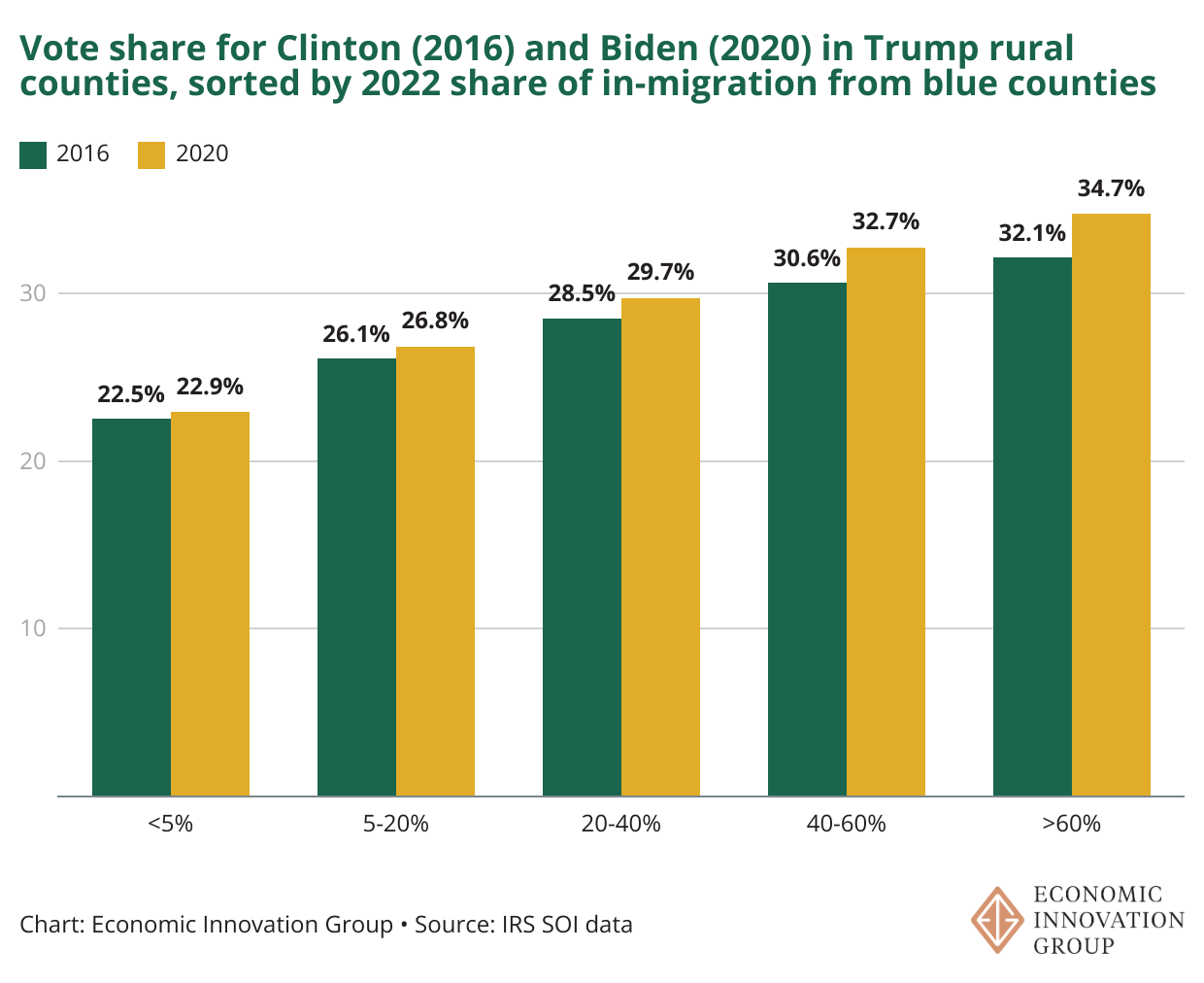How big-city expats might reshape the politics of rural America
The COVID-19 pandemic spurred an exodus out of the country’s large urban areas. Many people leaving big cities moved to rural areas, boosting rural county population growth. We know that most urban counties are blue, while most rural counties are red. What might this trend mean for the economies and politics of the rural areas where all these urbanites have moved?
We use IRS migration data to examine how these migration trends are playing out. While the implications for elections are uncertain, it is clear that many residents of blue urban areas are moving to red rural areas and, in particular, to the less polarized red rural counties.
Accelerating growth in rural America as large urban counties lose population
The pandemic has ushered in new migration patterns across the United States, with many people relocating from urban counties to less dense rural and exurban areas on the edges of metro areas. Fears of the virus, more flexible work options, and tight housing demand were all contributing factors to this out-migration from the country’s major cities.
After decades of relative stagnation, rural population growth accelerated in recent years — doubling from 0.7 percent in 2016-2019 to 1.4 percent from 2020 to 2023 (representing a gain of nearly one million residents). The trajectory of large urban areas, meanwhile, flipped from 1.5 percent growth to a 0.5 percent decline (a loss of more than 500,000 residents).
This surge of urban-to-rural migration can potentially reshape America’s political geography, affecting how votes are distributed across the urban-rural divide in the 2024 presidential race.
Rural Trump counties see rising blue county in-migration
IRS tax records allow us to trace population movement between counties, specifically focusing on whether people are relocating from blue counties — defined as those counties that voted for Biden in 2020 and Clinton in 2016 — to rural counties that supported Trump in the last two elections.1
In 2021, 33 percent of new residents in these Trump rural counties came from blue counties, the highest share in over a decade. In 2022, the last year for which the data is available, the share fell to 32 percent, which is still higher than before the pandemic.
The impact becomes even more pronounced when focusing on rural counties within urban commuting zones (rural countries in which a large share of residents commute to a nearby city for work). In these counties, the percentage of blue-county in-migration was 40 percent in 2022.
Moving to the least polarized areas
The data doesn’t reveal the political leanings of the people relocating. It would not capture, for instance, if disproportionately Trump-supporting residents in Democratic-leaning areas are choosing to move to Republican-voting areas. But the migration patterns nonetheless show interesting correlations with voting behavior.
Specifically, the Trump-supporting rural counties experiencing the largest influx of new residents from blue counties (as a share of total new residents) are the ones that were the least polarized in the 2016 and 2020 elections.
In Trump-supporting rural counties that received few newcomers from blue counties in 2022 (less than 5 percent of new residents that year), voting was overwhelmingly partisan towards Trump across both the 2016 and 2020 presidential elections, with Democratic candidates capturing less than 25 percent of votes in each.
The story differs in the Trump-won rural areas to which blue counties supplied more than 60 percent of new residents in 2022. These locations experienced an increase in Democratic support from 32 percent (for Clinton in 2016) to 35 percent (for Biden in 2020) — the most significant shift among any group of Trump rural counties.
Though the 2021-2022 newcomers obviously couldn't have influenced the 2016 and 2020 election results, these areas had already attracted residents from Democratic counties before COVID-19. The connection between migration from Democratic areas and reduced political polarization suggests these Trump rural counties may see even less partisan voting in 2024, especially given the recent acceleration in migration from blue counties.
Rural is the new exurban
Most rural counties experiencing a significant uptick in new residents from blue countries are not far from the country’s major metropolitan areas. The rural areas surrounding Austin and San Antonio showcase this trend, with numerous outlying counties attracting significant numbers of new residents from Democratic-leaning urban areas.
Medina County, Texas, is a good example. This rapidly expanding rural county, situated just outside San Antonio's metropolitan area, welcomed more than 2,000 newcomers from its Democratic-leaning urban neighbor in 2022. Although Medina County has remained reliably Republican in presidential elections since 2008, its Republican margin of victory in 2020 was narrower than in previous elections.
North Carolina's Research Triangle region exhibits a comparable trend. Franklin County, for instance, attracted almost 3,000 new residents from neighboring Wake County, where Raleigh is located. Much like Medina County in Texas, Franklin County has a history of voting Republican, and yet the Republican margin of victory fell noticeably in the 2020 election.
While these demographic shifts are concentrated in many swing states, their impact on the upcoming election remains uncertain — not only because the data doesn’t show the voting preferences of the movers but also because most of the movers are people relocating from urban areas to rural areas within the same state. The narrowing margins between candidates could well be the result of other factors beyond just population shifts.
Conclusion
The post-pandemic migration surge from urban to rural areas represents a significant demographic shift with potential political implications. While these changes haven't yet fundamentally altered the political character of most rural counties, they appear to be moderating extreme partisanship in areas receiving significant in-migration from blue counties. This trend suggests a more complex and nuanced political future for rural America, especially in areas with strong connections to urban centers.
The IRS data extends only through 2022 and captures data only for individuals who filed taxes, but it remains the most reliable public source for analyzing migration trends.







